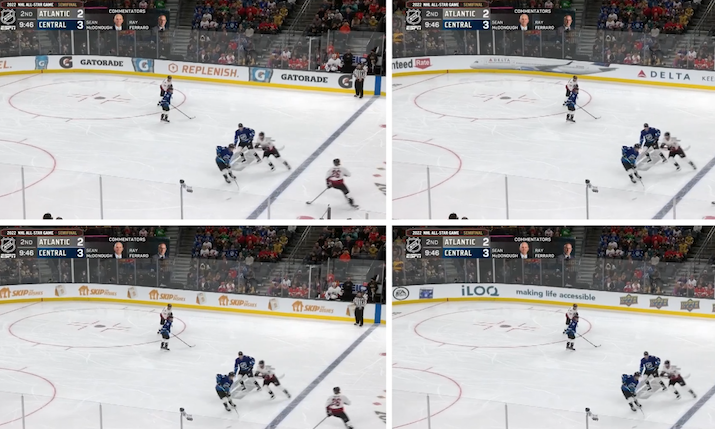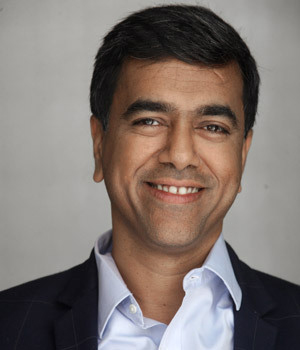Tech Focus: New ad tech tools take monetisation and engagement to the next level

Supponor’s long-term partnership with the NHL has seen its Digitally Enhanced Dasherboards system integrated into the live broadcast feed
In the first of a series of Tech Focus features, Imagine Communications, Supponor, uniqFEED and Amagi share their insights into the latest ad tech tools and the journey to more targeted advertising.
How to effectively monetise content while delivering a memorable experience for viewers has been a talking point across the broadcast industry for some time, and sports is no different. While viewers expect a high-quality experience, advertisers need to see a clear return on investment (RoI) on their often large investments, so reaching the right audience in the right way is essential. Ad tech solutions have advanced significantly in recent years, turning away from traditional, static and passive options into active, targeted tools, but are these delivering what sports clients need?
Rob Malcolm, general manager of ad tech for Imagine Communications, explains: “There are two overarching objectives for sports providers. The first one, and by far the most important one, is how to maximise the yield of the advertising.

Rob Malcolm, Imagine
“The second relates to the dynamic nature of sport which can create unique problems for advertising. So, if a game is running long, for example, and there’s unexpected inventory, how do you ensure that you can anticipate those changes and continue to monetise things? Those two overarching objectives are, to some degree, always driving technology change, technology improvements and technology requirements.”
David Patton, SVP, partner and market development at Supponor, agrees, adding: “Sports clients are looking for solutions that enable them to maximise their commercial opportunities and returns, offering a flexibility of inventory that can increase reach and minimise wastage for their global partners. This is both to support global brands with localised messages and also multiple local and regional brands simultaneously.”
Tom Huston, chief commercial officer at uniqFEED, explains how this can be achieved: “In today’s world, marketing success is all about customisation and creating more personal experiences and connections for consumers and fans. Sports clients such as leagues and federations are looking for solutions that will help them to offer greater commercial options, flexibility and value to their stakeholders – clubs, members, commercial partners – which in turn enables the organisation as a whole to provide deeper, more engaging fan experiences, generating growth and greater revenues in the process across the entire ecosystem.”
He points to the need for well-designed commercial programmes combined with integrated ad tech solutions, whether at a local, national, or international level, to deliver these results.
The switch to streaming
The transition from most sport being consumed primarily via traditional broadcast and satellite to content being streamed is creating more opportunities to deliver personalised, targeted advertising.
Malcolm adds: “The reason why it’s moving towards streaming is because latency is reduced and you can watch HD and UHD over a broadband connection, which basically gives advertisers the ability to be much more targeted in terms of the advertising, and that will generate greater yields as well. And so, in terms of their yield management, it’s a combination of creating more inventory, and then trying to figure out how to maximise the value of that inventory, either through targeting of the audience, or through optimisation-type algorithms that we at Imagine specialise in, to try and put the right ad in the right place for the right audience.”
“Advancements in ad technology will focus on making user experiences richer and more personal”
Srinivasan KA, co-founder and chief revenue officer at Amagi, agrees on the main aims of ad tech solutions, citing innovations such as targeted sponsorships, personalised overlays and picture-in-picture, as well as the growth in server-side ad insertion (SSAI).

Srinivasan KA, Amagi
“Sports clients want to ensure that SSAI solutions can scale to high concurrency and do not add any significant latency to the streams,” he adds. “SSAI solutions for sports must ensure that the ad experience is seamless, and the quality is uncompromised. 4K/HDR solutions are critical for sports.”
He specifically mentions Amagi’s flagship ad solution Thunderstorm 3.0, a hyperscale SSAI tool built for high volume applications that also allows innovative ad formats such as L-bands, lower thirds and on-screen badges, to maximise advertising opportunities for rights owners.
While these tools all help with the goal of delivering more advertising and generating more revenue, the challenge is to do this without impacting viewers’ enjoyment of the game.
“There are a handful of clever things being tried here, such as with MultiChoice [operator of Africa’s premier sports broadcaster, SuperSport], where basically the lower third or a quarter screen shows sponsorship during the game while you can still watch the game. It’s hardly noticeable, but it creates more inventory,” says Malcolm.
Virtual advertising solutions are also growing in popularity, with the likes of European handball, Swiss-Ski and the Paris Masters all recently making significant investments. According to Supponor, its fully software-based Supponor Air virtual advertising technology is being deployed in over 2,500 live sports events across Europe, North America and Australia during the 2022-2023 football season, underlining this increase in demand.
“Ad tech is a hot area of market development on a global scale,” confirms Patton, “especially the fast-growing virtual advertising driven by the increasing globalisation of live sports and underpinned by the entry of more regionalised distribution such as OTT platforms for sports.”
Huston at uniqFEED adds: “With virtual advertising, sponsors and advertisers can better tailor their message to desired target audiences with regionalised messaging as well as increasingly immersive experiences, such as interactive advertising and user-generated content campaigns.”
uniqFEED itself offers a software-based solution that enables sports rightsholders to multiply live in-game sponsorship inventory without the need for any special equipment or complications to on-site operations.
“We insert dynamic or static sponsored content digitally, directly into the broadcast feed ‘erasing and replacing’ the existing ads that are physically in place in the venue and in a photo-realistic way such that the home viewer isn’t even aware that what they are seeing is a digital overlay,” he adds.
Ad tech challenges
While better connections with fans and improved RoI for customers will appeal to most, finding and implementing ad tech solutions is not without its challenges. These include cost, integration, privacy regulations and fragmentation.
“The costs associated with onboarding new technology can feel steep at the onset, especially if the customer is not fully confident in their ability to successfully monetise the new assets that are created,” expands Huston.
Benjamin Fabricius, uniqFEED head of product management, also points to changing privacy regulations that look likely to have an impact.
“From 2024 onwards, third-party cookies are being eliminated by Google, which means that advertisers will no longer be able to target audiences based on user behaviour across the web and will instead need to rely on first-party cookies.”
While in the short term this will almost certainly make it more difficult to implement the hyper-personalised programmatic ad targeting such as for OTT that is common practice today, it may have benefits in the longer term.
“OTT and streaming platforms could stand to benefit from this change as their audiences can be segmented into groups of viewers with similar preferences by using subscriber data profiles,” adds Fabricius.

UniqFEED’s Benjamin Fabricius speaking at SVG Europe’s Create, Share, Engage event
“Segmenting to large groups or ‘cohorts’ of similar people will make greater market segmentation possible for in-game advertising on OTT platforms. Costing will most likely adjust accordingly, shifting from a cost-per-ad impression to a cost-per-target cohort and the overall time that an ad was exposed to a target group.”
Rightsholders will also need to restructure existing sponsorship models to allow for greater market segmentation, upselling to brands that truly want and need full global exposure and exclusivity, while carving out exclusivities in regional markets where it is actually needed.
“This will eliminate waste by allowing ad tech to commercialise all non-category exclusive categories and markets. What is clear is that technology is opening the door to vastly greater options for commercial creativity and deal making, where sponsorship and traditional advertising live side by side within live sport broadcasts,” says Huston.
Srinivasan KA believes that demand sourcing is still one of the main pain points. “The demand landscape is fragmented on Connected TV-led programming and customers are obliged to work with multiple demand partners to reach their optimum level of monetisation. Automated ad scheduling (or dayparting), frequency mapping, measurement, identification and ad fraud are some other problems currently plaguing the linear streaming landscape.”
Looking to the future there is broad consensus that data is going to play a critical role in the development of ad technology.
Srinivasan KA adds: “Data will help us understand consumption patterns and personalise ads to each user’s needs and preferences. Programmatic ad networks in the CTV space are likely to mature with rights owners implementing superior solutions such as dynamic ad insertions and personalised contextual ad placements. Furthermore, the gap between streaming and ads will be bridged with centralised identity, content recommendations in lieu of ads and more. In a nutshell, advancements in ad technology will focus on making user experiences richer and more personal.”
Huston adds: “As sport consumption becomes increasingly digitalised, sport organisations have access to vast amounts of new fan data that wasn’t available or possible to collect even a few years ago.
“New ad tech solutions, such as virtual advertising deployed within OTT streaming platforms, allow for ever increasing levels of audience segmentation and soon will even allow for individual targeting within live sport broadcasts. Ad tech will provide both brands and rightsholders with huge amounts of data and insights into how fans are interacting with advertising content, such as CTRs and conversions. Return on investment will therefore be easier to calculate.”
“Advancements in virtual advertising technology are progressing rapidly, making the capability of programmatic buying theoretically possible”
“It’s only a matter of time until everything is streamed,” believes Malcom. “And I think that the technology is going to become more and more sophisticated, both in terms of being able to deliver the absolute best experience, like UHD, and the highest quality viewing experience possible.
“But I think that streaming capability also allows for much more interactive watching, and you don’t just have one stream, for example, you can have multiple streams, because of the economics of having things deployed in the cloud. The fact that every stream is ultimately individual anyway means that you have a much more targeted way of delivering content. And then obviously, from an advertising standpoint, it also means that you can have much more targeted advertising.”
Huston concludes: “There is also the potential for a seismic shift towards traditional advertising-based models rather than the current sponsorships-dominated model if programmatic advertising is to be possible in-game.
“Programmatic advertising is an automated process, where advertising inventory is bought and sold through a real-time bidding system. Placements and targeting are determined by machine-learning algorithms. The process needs to be quick and flexible to be truly effective. Advancements in virtual advertising technology are progressing rapidly, making the capability of programmatic buying theoretically possible.”

